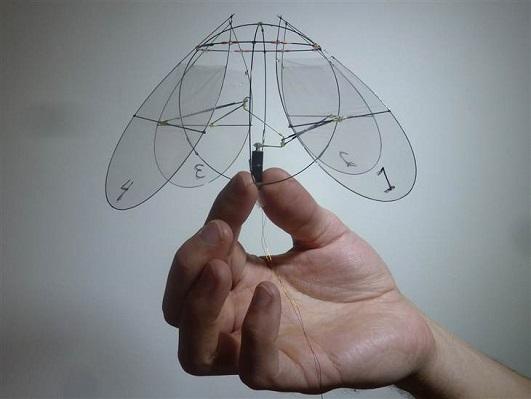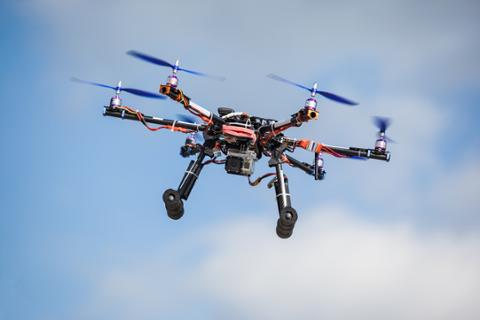
A team of NYU mathematicians looking for ways to give tiny flying robots the agility of house flies has demonstrated a prototype, weighing seven-one-hundredths of an ounce, that flies using the motion of a swimming jellyfish. While the prototype flies, it can't control its own motion, can't be remote-controlled, and gets its power from wires that tether it to the ground, all of which would make it a non-starter as a micro-scale robotic surveillance drone. Nonetheless, the inventors think the device may one day evolve from an initial design that is "sort of dumb," according to research team leader Leif Ristroph, assistant professor at New York University's Courant Institute of Mathematical Sciences. Though Ristroph specializes in biolocomotion – machines that move by mimicking the methods of animals or plants – the realization that the prototype moved like a jellyfish came during testing, not as an inspiration for the original design. (Video available here.) The intention was to create a flying mechanism that could be as small as the wings on a fly, with some of an insect's agility and speed in flight, which could allow tiny surveillance drones to fly into crowded or enclosed areas to spy on the inhabitants. Flies are among the most agile fliers in the animal world, but anything that flies using wings that flap will be unstable in flight due to the up-and-down motion of the wings. Insects compensate by monitoring their environments for every gust of wind or unexpected hazard and adjusting flying motion in fractions of a second. But building that level of control into a bug-sized flying spy is difficult. Fixed-wing or rotor-based designs work fine, but are difficult to shrink to insect scale. Ornithopters – machines that use flapping wings to fly, usually in imitation of birds or insects – are easier to shrink but harder to fly. Other than the wings themselves, a small-enough ornithopter would have no other control surfaces to help stabilize it, Ristroph said in a statement announcing the Nov. 24 presentation "Hovering of a jellyfish-like flying machine," which he wrote with Courant Institute co-author Stephen Childress, at a conference of the American Physical Society over the weekend. The model developed by Ristroph and Childress flies by flapping four equally-sized oval wings out of sequence, rather than on matching cycles, during which two wings are always up while the other two are down. A vehicle whose moving parts move asymmetrically should not be able to fly, according to standards and expectations based on more than a century of fixed-wing flight design. Ristroph and Childress studied the fluid dynamics of the motion, however, rather than how it compared to the design of other aircraft. Each wing-flap provides thrust to keep the vehicle in the air; Ristroph and Childress timed the flapping of each wing to compensate for the effect of the others, resulting in a vehicle that can hover, ascend, descend and fly purposely in a chosen direction – if it has any flight controllers on-board. The purpose of the prototype was to prove that a tiny, asymmetrically flapping not-quite-a-jellyfish could engage in stable-enough flight to justify investing in the effort to create additional flight and navigation controls. Though Ristroph actually points out the resemblance to the movement of a jellyfish, the robot's flight is more akin to that of a moth, he said, though not one with much sense of direction. Even at 8 centimeters across (3.1 inches) and 2 grams (0.071 oz), it's big for a bug-sized spy drone. Oddly, however, the ability of the jellyfish design to fly depends more on the power of its motor than its shape or environment. With enough power on board, even much larger versions should fly at least as well, Ristroph said. "Our [robot] is an aerial jellyfish if you will," Ristroph told NBC News. "No one's ever built this, and as far as we know nature never built it either to fly in air. Maybe that indicates that it's a bad idea? In any case we got it to work, so maybe not that bad." Image: Leif Ristroph/NYU


